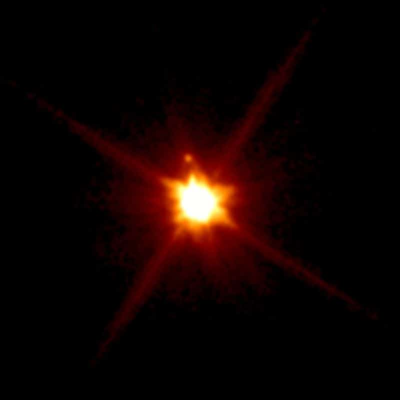Signs of an active volcano have been observed for the first time on the dwarf planet.
Makemake is a dwarf planet, one of the largest and brightest objects in the Kuiper Belt, located approximately 45 times farther from the Sun than Earth. In 2007, the infrared space telescope "Spitzer" assisted astronomers in measuring the diameter and albedo of Makemake. According to these measurements, the diameter of the dwarf planet is about 1500 kilometers, and its geometric albedo is 0.8.
The surface of Makemake is primarily covered with methane ice, as well as products that remain after methane evaporates under sunlight (for example, tholins — a mixture of organic copolymers). In 2024, a group of geochemists from the USA conducted an analysis of the isotopic composition of methane on the dwarf planet using the James Webb Space Telescope. By studying the relative abundance of different isotopes in the material, scientists gain insights into its formation and evolutionary characteristics.
The results of the analysis of various hydrogen isotopes in methane indicated evidence of geothermal processes within Makemake's interior. This means that the methane on the surface of the dwarf planet has geochemical signatures suggesting it originated in hot conditions — for instance, due to volcanic activity. This distinguishes it from the methane found on comets.
In 2015, the New Horizons spacecraft discovered similar signs on the surface of another dwarf planet, Pluto, specifically traces of cryovolcanism, which by that time was no longer active. Cryovolcanoes are a type of volcanism that occurs under low-temperature conditions. Instead of molten rock, they erupt water, ammonia, and methane — both in liquid form (cryolava) and in gas form.
Subsequently, similar traces were found on another dwarf planet — Ceres. At that time, scientists suggested that cryovolcanism was not a rare phenomenon among trans-Neptunian objects. However, a functioning volcano on a dwarf planet has yet to be discovered.
Before the New Horizons mission, specialists believed that since Makemake is located far from the Sun (at a distance of 5.6-7.9 billion kilometers), it is too cold for volcanic activity. The equilibrium temperature there is approximately minus 244 degrees Celsius. Additionally, it was thought that the celestial body does not have sufficient size to initiate such processes.
A team of astronomers from Hungary, led by Csaba Kiss from the Konkoly Observatory, has likely obtained evidence of volcanic activity on Makemake that is occurring right now (at the time of writing this article).
The researchers detected thermal radiation in the infrared spectrum (in the range of 18-25 micrometers, μm) corresponding to a temperature of minus 120 degrees Celsius, which is significantly higher than Makemake's average temperature of minus 244 degrees. The scientists made this discovery using the MIRI spectrograph mounted on the James Webb telescope.
The researchers explained the temperature changes with two possible reasons. The first, and according to the authors of the study, the more likely one — is the activity of a cryovolcano. The second — is the fine-grained dust surrounding Makemake.
If the reason for the temperature fluctuations is cryovolcanic activity, it means there is an active cryovolcano on the surface of the dwarf planet, possibly beneath which lies a liquid ocean. Most likely, this ocean has remained liquid since its formation due to latent heat within the dwarf planet.

According to Kiss, the ocean likely does not consist of the familiar water but contains impurities of ammonia and salts of other substances. Furthermore, the cryovolcano itself may appear quite different to observers than what astronomers are accustomed to seeing on other bodies. For instance, it could be a crack in the crust through which methane is expelled to the surface.
The temperature changes could also be caused by fine-grained carbon dust heated by the Sun, which may surround Makemake in the form of a thin ring. It is even possible that the temperature anomaly is due to both of these processes, somehow linked: for example, the cryovolcano ejects fine-grained material into space.
To fully understand the issue, longer observations of Makemake are necessary. In a study published on the electronic preprint archive arXiv.org, the authors noted that they studied the dwarf planet for less than an hour.
In any case, it does not matter what causes the temperature change — whether it is the cryovolcano or fine-grained dust: both scenarios would be sensational. Firstly, scientists have never discovered a ring of fine-grained dust around dwarf planets. Secondly, an active cryovolcano in the Kuiper Belt is a unique phenomenon in itself.